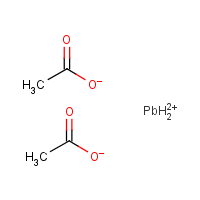Lead(II) acetate
Agent Name
Lead(II) acetate
CAS Number
301-04-2
Formula
C2-H4-O2.1/2Pb
Major Category
Metals

Synonyms
Acetate de plomb [French]; Acetic acid lead(2+) salt; Acetic acid, lead salt; Acetic acid, lead(2 +) salt; Bleiacetat [German]; Dibasic lead acetate; Lead acetate; Lead acetate (Pb(Ac)2); Lead acetate (Pb(O2C2H3)2); Lead acetate (anhydrous); Lead diacetate; Lead dibasic acetate; Lead(2+) acetate; Lead(II) acetate; Normal lead acetate; Plumbous acetate; Salt of saturn; Sugar of lead; Unichem PBA; [ChemIDplus] UN1616
Category
Organic Acids, Metal Salts
Description
Colorless to white solid; [ICSC] Brown or gray solid (commercial grades); [CHEMINFO]
Sources/Uses
Used in varnishes, lead driers, chrome pigments, antifouling paints, analytical reagents, astringents, water repellants, hair dyes, and mordants for dyeing cotton; Also used in gold cyanidation process and to make insecticides, cosmetics, and perfumes; [HSDB]
Comments
A skin, eye, and mucous membrane irritant; [CAMEO] See "Lead" and linked occupational diseases.
Biomedical References
Exposure Assessment
BEI
Lead in blood = 200 ug/L (20 ug/100 ml); sampling time not critical; [ACGIH]
TLV (ACGIH)
0.05 mg/m3, as Pb
PEL (OSHA)
0.05 mg/m3, as Pb
Vapor Pressure
0.000722 mm Hg
Explanatory Notes
mp = 280 deg C; [ATSDR ToxProfiles]
Adverse Effects
Anemia
Hemolytic anemia
Neurotoxin
Predominantly motor
Nephrotoxin
Yes
Reproductive Toxin
Yes
IARC Carcinogen
Probable (2a)
NTP Carcinogen
Anticipated human carcinogen
ACGIH Carcinogen
Confirmed Animal
Diseases, Processes, and Activities Linked to This Agent
Diseases
Occupational diseases associated with exposure to this agent:
Processes
Industrial Processes with risk of exposure:
Activities
Activities with risk of exposure: